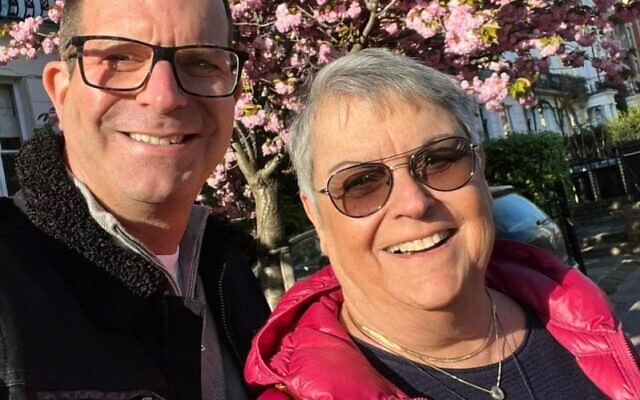Revealed: Hostage was ‘sold’ to Islamic Jihad during Gaza captivity
Startling details emerge of Ada Sagi’s 54 days in the hands of Hamas
Jenni Frazer is a freelance journalist
New details of what had happened to one of the Gaza hostages, Ada Sagi, emerged during an interview with her London-based son, Noam, at the St John’s Wood audience event on Monday evening. The 75-year-old Arabic and Hebrew teacher had been “sold” to another group, Islamic Jihad, and was kept in a civilian apartment belonging to a lawyer, before finally being released after 54 days in captivity.
After the screening of a short video about Kibbutz Nir Oz and the increasingly frantic text messages sent by the residents about the Hamas terrorists who had invaded the kibbutz, Noam Sagi, in conversation with journalist Sandy Rashty, spoke about his upbringing on Nir Oz, where he lived until he was 18.
“It’s a very small community, and a very tight family community,” he said. “What’s special about it is that it is a very green spot in the middle of the Negev. It was a space for prosperity, for freedom, happiness, for just being on your bicycle… the simplicity and beauty of our lives there, that’s what it was.”
On the morning of 7 October, Noam Sagi was at home in London and received a message from his sister in Israel telling him on no account to try to call their mother. He had already received “loads” of messages from people who knew that he was from Nir Oz and that his mother lived there. “We just thought it was just another Code Red, but we were used to that. But the message from my sister said, no matter what, don’t call mum, for her own safety, don’t call her. That was alarming enough.”
At 9.24 am Ada Sagi had spoken to her daughter and said she had seen men outside her house with kalashnikovs and RPG weapons. She had gone into the safe room — “and that was the last we heard. As the day unfolded we believed that she was in the safe room, and we hoped and prayed that she was alright.”
But at midday Noam Sagi saw on social media “a Hamas reporter on my mother’s front lawn. This was where my heart dropped… it was impossible that someone could remain unharmed in such a situation”.
Soon he learned of the fate of so many people on the kibbutz whom he knew intimately, of the burning and ransacking of their houses. By 6pm Israel time, he said, the army told the Sagis that they had been into Ada’s house and she was not there. “She was not on the dead list or the rescued list.” It was assumed she had been captured and taken to Gaza.
Ada Sagi’s house remains one of the few on the kibbutz which is still standing, but Noam Sagi, who grew up there, said he couldn’t recognise it when he first visited, so bad was the destruction.
In London, he turned himself into a whirlwind of campaigning on behalf of his mother and all the hostages. “I don’t know what I did, it was instinct. You do what you have to do, it’s your mum, you love her.”
He described his mother as “very switched-on. The first thing [the terrorists] did was to throw away her glasses and put the back of a kalashnikov on her head. They put her on the back of a motorbike and attached the inside of her heel to the exhaust so that it burned, this was something that they did to all the hostages as a way of marking them. Ten minutes later, she was already in Khan Yunis [in the south of the Gaza Strip]. For all of her captivity she was 10 minutes away from home.”
Since her release she has spent a great deal of time talking to the security services “because she knows so much. She figured out what was going on and she understood it at the same time because she speaks Arabic, When they [the terrorists] listened to Al-Jazeera, she would put her ear to the door.
“She is a very resourceful human being. She managed to find a system how to know which day it was and what time… she was held as a human shield on the top floor of a house, together with another person. That room was sealed.” The house was owned by a lawyer. Noam Sagi added: “She had been sold to Islamic Jihad, so she knew it was a business transaction, and in order to get money, they needed to keep her safe. They called her ‘diamond’ so she knew she was worth a high price— and she used that to her advantage. She was the only one who came out of Gaza without traces of drugs in her blood”.
Because the house where Ada Sagi was kept became a place where other people moved in and out, she knew information about the tunnels and the terrorists and the conditions in which other hostages were held.
Thirty members of Kibbutz Nir Oz are still in captivity. Initially on her release, Ada Sagi spent time in a hotel, but has now relocated to Kiryat Gat with what remains of her kibbutz community, who her son says are broken. “When she came back, she had to realise that she had no home to go back to — that the kibbutz is gone. She actually learned that from one of the kids, because the Hamas terrorists took the kids on bikes through the kibbutz to show them the burning houses, to say, this is what we did to your community. So she knew about the kibbutz: but she didn’t know how many of her friends had gone.”
Though Noam and his sister and brother were naturally happy that their mother had returned from Gaza, the fight was not over, he said. He would continue to campaign “until the last hostage is back with us”.

Thank you for helping to make Jewish News the leading source of news and opinion for the UK Jewish community. Today we're asking for your invaluable help to continue putting our community first in everything we do.
For as little as £5 a month you can help sustain the vital work we do in celebrating and standing up for Jewish life in Britain.
Jewish News holds our community together and keeps us connected. Like a synagogue, it’s where people turn to feel part of something bigger. It also proudly shows the rest of Britain the vibrancy and rich culture of modern Jewish life.
You can make a quick and easy one-off or monthly contribution of £5, £10, £20 or any other sum you’re comfortable with.
100% of your donation will help us continue celebrating our community, in all its dynamic diversity...
Engaging
Being a community platform means so much more than producing a newspaper and website. One of our proudest roles is media partnering with our invaluable charities to amplify the outstanding work they do to help us all.
Celebrating
There’s no shortage of oys in the world but Jewish News takes every opportunity to celebrate the joys too, through projects like Night of Heroes, 40 Under 40 and other compelling countdowns that make the community kvell with pride.
Pioneering
In the first collaboration between media outlets from different faiths, Jewish News worked with British Muslim TV and Church Times to produce a list of young activists leading the way on interfaith understanding.
Campaigning
Royal Mail issued a stamp honouring Holocaust hero Sir Nicholas Winton after a Jewish News campaign attracted more than 100,000 backers. Jewish Newsalso produces special editions of the paper highlighting pressing issues including mental health and Holocaust remembrance.
Easy access
In an age when news is readily accessible, Jewish News provides high-quality content free online and offline, removing any financial barriers to connecting people.
Voice of our community to wider society
The Jewish News team regularly appears on TV, radio and on the pages of the national press to comment on stories about the Jewish community. Easy access to the paper on the streets of London also means Jewish News provides an invaluable window into the community for the country at large.
We hope you agree all this is worth preserving.






















